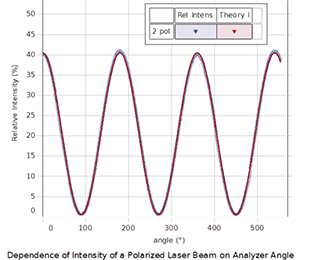Description
In this experiment, Malus’ Law of Polarization is verified by showing that the intensity of light passed through two polarizers depends on the square of the cosine of the angle between the two polarization axes.
Laser light (peak wavelength = 650 nm) is passed through two polarizers. As the second polarizer (the analyzer) is rotated by hand, the relative light intensity is recorded as a function of the angle between the axes of polarization of the two polarizers. The angle is obtained using a Rotary Motion Sensor coupled to the polarizer with a drive belt. The plot of light intensity vs. angle can be fitted to the square of the cosine of the angle.
PASCO Advantage: Laser light is used in this experiment because its wavelength is more completely extinguished by the crossed polarizers.
Experiments
Software Required
This product requires PASCO software for data collection and analysis. We recommend the following option(s). For more information on which is right for your classroom, see our Software Comparison: SPARKvue vs. Capstone »
Interface Required
This product requires a PASCO Interface to connect to your computer or device. We recommend the following option(s). For a breakdown of features, capabilities, and additional options, see our Interface Comparison Guide »
Concepts
- Measure the Zeeman Effect with polarization perpendicular and parallel to the field
- Observe the light along the magnet axis
- Calculate the value of the Bohr magneton
- Malus’ Law of Polarization
What’s Included
- 1x Polarization Analyzer — Basic Optics (OS-8533A)
- 1x Electromagnet
- 1x Optics Benches (60 cm) (OS-8541)
- 1x Power Supply
- 1x Red Diode Laser – Basic Optics (OS-8525A)
- 1x Optics
- 1x PASPORT High Sensitivity Light Sensor (PS-2176)
- 1x Tesla Meter
- 1x PASPORT Rotary Motion Sensor (PS-2120A)
- 1x PASCO Capstone Single User License
Support Documents
Basic Optics Red Diode Laser Manual
PASPORT High Sensitivity Light Sensor Manual
PASPORT Rotary Motion Sensor Manual
Polarization Analyzer Basic Optics Manual



